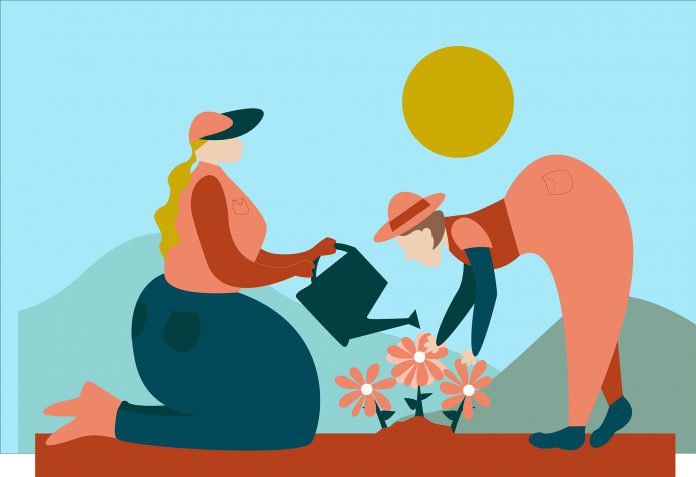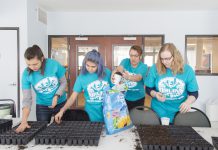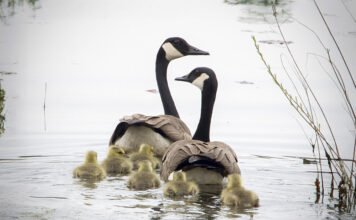
It’s a cool Friday morning on campus at Kellogg Community College, and while it’s cold and windy, students and volunteers from the Battle Creek area are starting to show up outside the on-campus community garden. Wearing Bruins Give Back T-shirts, the volunteers are sitting, waiting to begin the process of preparing the garden for summer planting.
Kate DeGraaf, director of KCC’s Integrative Learning Department and head of the event, stands next to the greenhouse.
“Thank you all for coming here today,” she says.
For some, this might seem like an ordinary community garden, but there’s much more to it than one might suspect. For starters, everything grown in the garden usually goes to help out the community. KCC is very proud of helping and donating everything grown in the garden to people in need.
“In previous years, we’ve had different organizations that we’ve donated to,” DeGraaf said. “Haven of Rest, SAFE Place, Silver Star veterans, to name a few places that we’ve donated to. We also donate to students who are in need. All of the things that we grow in the garden go back to the community, which is beautiful.”
KCC’s community garden started in the summer of 2014 as a unity project in collaboration with the Youth Exchange and Study (YES) Program and the Battle Creek community. Joseph Marah, an international student at KCC at the time, proposed the idea of building a community garden with a $3,000 scholarship that he won.
With the help of DeGraaf, now the director of the YES-KCC Community Garden, they were able to start the garden using the scholarship money to get raised beds. This summer they are celebrating their fifth year, with many more coming.
Basic & Educational
The idea behind community gardens is basic and educational. As gardener Ron Finley, of The Ron Finley Project turning unused spaces into gardens and community hubs in Los Angeles, says, “If a child plants broccoli, he will eat broccoli.”
Seeing community gardens as a way to deal with gas shortages, poor urban conditions, and an increase in food prices, communities across urban areas in the United States have been starting such gardens for decades.
According to the America Community Gardening Association, there are 18,000 community gardens in the U.S., and researchers have been studying their impacts. In almost all reports, communities with community gardens see a significant decrease in violence. A clear example of this is a community in North Philadelphia, which changed radically thanks to The Parcels Community Garden and Kitchen. Crime, violence and unemployment are still present in the community, but people are taking much better care of their properties, and as a result the neighborhood has undergone a transformation.
Apart from these benefits that help the community as a whole, there are also the economics and how much money these community gardens can actually help save. At supermarkets, organic food can be more costly than non-organic food (which is often synonymous with GMOs or genetically modified food). Having your own garden or being a part of these community gardens can not only help save a lot of money, but it also allows people to build relationships of mutual dependence with nature and each other.
Additionally, planting a garden of vegetables and fruit can help with creating new and healthier eating habits.
Urban lifestyles have unfortunately taken away the sense of community that many people have. Often, neighbors are virtually unknown. People greet each other as they pass, but nobody really knows each other. This is another reason why community gardens can be so important. Not only they are giving back and helping the community, but they allow social interaction to take place at a symbolically relevant site.
Things like our community garden at KCC and events like Bruins Give Back bring the community together, and events like this are very important in the process of joining as a community together to work for a cause that helps everyone.
“Apart from cleaning and preparing the area, I liked the sense of community that it brought to us. Working as a group was definitely my favorite part,” Melina Tindol, a KCC student and one of the Bruins Give Back volunteers, said.
The Big Kickoff
Sierra Thurmond works alongside DeGraaf at Bruins Give Back, and they see the event as a big kickoff for the garden in order to prepare it for harvest during the summer and the fall. The main purpose was to get everything cleaned up from the winter and to prepare it for the next big planting day, which will be held May 20.
“I am usually working over at the community garden every day during the summer season, along with students and volunteers that are there during the summer as well,” Thurmond says.
For three hours, students and volunteers work to get things done around the garden. As it reaches noon, everyone involved in this last Bruins Give Back of the spring semester finishes up their work. At the end, signs are painted, the area is clean and dirt is prepared for planting.
“Thank you all for coming,” DeGraaf says. “We really appreciate the help.”
For more information about volunteer opportunities at KCC or about KCC’s community garden, contact DeGraaf at 269-565-7991 or degraafk@kellogg.edu.
























